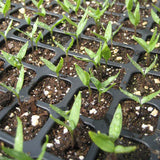
Growing Great Tomato Transplants

Year after year, tomatoes continue to top the popularity charts of crops for home gardeners. We wouldn’t dare argue: there’s nothing like a perfectly ripe, juicy, home-grown, and sun-warmed tomato straight from the field. But, year after year, tomatoes also continue to perplex some growers: unlike easier-going crops, tomatoes need extra attention to succeed. That’s why we’ve created an arsenal of resources to help you grow strong, healthy, and fruitful tomatoes. Continuing the series are our best tips for growing great tomato seedlings:
Don't Rush It.
Tomato seed starting is time sensitive, but on a certain timeline. A lot of gardeners rush to get seeds started with out knowing what the best timeline it. We prefer seedlings that are 6-8 weeks old and like to transplant them right around our last frost date on may 15th. That means we start seeds no earlier than the last week of March, and typically right around the first of April is when we really get started with them.
Give Air.
After choosing your favorite heirloom tomato seeds and following Erin’s Tomato Seed Starting Tips, wait 10 to 14 days for them to germinate. Once the seeds sprout, be sure to remove any cover you may have placed on top to avoid damping off. Tomatoes are susceptible to fungal diseases and providing them with consistent airflow throughout their lives indoors helps. Setting up a fan near the seedlings is effective in preventing fungal problems and also makes for stronger plants: the imitation wind motivates them to reinforce their stems.
Water, not too much.
For similar considerations as above, approach watering with care. To avoid disease, it’s best to let the soil dry out in between watering. But, don’t let it stay dry long – soil in pots can dry quickly and young plants can’t go long without moisture. If possible, water the soil directly (next to the stem) instead of watering the foliage from overhead.
Warm up, Light up.
Tomatoes hail from the tropics and thrive in the heat. Although they can handle a range of temperatures, they prefer highs around 80 degrees, and nighttime lows no lower than 60. Young tomatoes also benefit from long hours of intense light. Between 10 and 14 hours is ideal, so if growing indoors, give your seedlings a grow light to avoid weak and spindly starts.
Re-pot, Repeat.
If tomato seeds are planted close together or in shallow pots, they’ll need to be re-potted at least once before they move outdoors, which is great. Choose containers that are at least 3x3x3x inches. We are very fond of these ceramic pots, so fond that we added these practical, reusable, and beautiful pots to our catalog. (Did we mention they are self-watering?) Once the seedlings have four true leaves, it’s time to pot-up. Pinch off the baby leaves (cotyledons), remove the plants carefully (a spoon can help dislodge the roots without disturbing them), and replant in the new pot with most of the stem buried and just the leaves above the soil line. This last step is crucial: tomatoes have tiny hairs along the stem that, when placed in soil, form new roots. The deeper you replant, the stronger a tomato’s root system will be. Every move to a bigger pot is an opportunity for the plant to grow more roots, including the final move out into the garden. It’s a good idea to pot up once more if your seedlings reach 10 inches, but it’s still too early to move them outside. Just be sure to pinch off the bottom set of leaves when you pot-up.
On to transplanting.
After following the steps above and waiting till it’s safely past the last frost date, it’s time to transplant your baby tomatoes. Read on for our Ten Tomato Transplant Tips.











